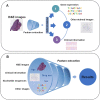Multi-modality artificial intelligence in digital pathology
- PMID: 36124675
- PMCID: PMC9677480
- DOI: 10.1093/bib/bbac367
Multi-modality artificial intelligence in digital pathology
Abstract
In common medical procedures, the time-consuming and expensive nature of obtaining test results plagues doctors and patients. Digital pathology research allows using computational technologies to manage data, presenting an opportunity to improve the efficiency of diagnosis and treatment. Artificial intelligence (AI) has a great advantage in the data analytics phase. Extensive research has shown that AI algorithms can produce more up-to-date and standardized conclusions for whole slide images. In conjunction with the development of high-throughput sequencing technologies, algorithms can integrate and analyze data from multiple modalities to explore the correspondence between morphological features and gene expression. This review investigates using the most popular image data, hematoxylin-eosin stained tissue slide images, to find a strategic solution for the imbalance of healthcare resources. The article focuses on the role that the development of deep learning technology has in assisting doctors' work and discusses the opportunities and challenges of AI.
Keywords: deep learning; digital pathology; multi-modality; whole slide images.
© The Author(s) 2022. Published by Oxford University Press.
Figures



References
-
- Konig IR, Fuchs O, Hansen G, et al. . What is precision medicine? Eur Respir J 2017;50(4):1700391. - PubMed
-
- Cardiff RD, Miller CH, Munn RJ. Manual hematoxylin and eosin staining of mouse tissue sections. Cold Spring Harb Protoc 2014;2014(6):655–8. - PubMed
-
- Fischer AH, Jacobson KA, Rose J, et al. . Hematoxylin and eosin staining of tissue and cell sections. CSH Protoc 2008;2008:pdb.prot4986. - PubMed
Publication types
MeSH terms
Substances
Grants and funding
- 2021YFC2500203/National Key Research and Development Program of China
- XDA16021400/Strategic Priority Research Program of the Chinese Academy of Sciences
- LY20C060001/Zhejiang Provincial Natural Science Foundation of China
- E161080/Innovation Fund of Institute of Computing and Technology
- JBZX-202003/Zhejiang Provincial Research Center for Cancer Intelligent Diagnosis and Molecular Technology

